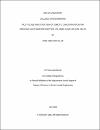Pilot-Scale Investigation of Osmotic Concentration for Reducing Wastewater Injection Volumes in Qatari Gas Fields
| المرشد | Nasser, Mustafa S. |
| المؤلف | Jalab, Reem Abrahim |
| تاريخ الإتاحة | 2020-07-15T09:27:49Z |
| تاريخ النشر | 2020-06 |
| الملخص | In the past 10 years, forward osmosis (FO) has been capturing the attention as a low-energy membrane technology for wastewater reclamation. FO relies on the osmosis phenomenon from osmotic pressure difference across semi-permeable membrane. The permeate water is drawn by the effect of high saline draw solution (DS) turning diluted with permeate transfer and leaving the wastewater feed solution (FS) concentrated. Through permeation, net driving force diminishes from the reduced salinity of DS that can be recovered via high-energy consumption step. However, the energy benefit of FO technology emerges when DS recovery step is obviated and FO is applied for osmotic concentration (OC). In fact, FO as an OC process is best suited for volume reduction of wastewater from oil and gas wells’ drilling to be injected into underground wells. In literature, the OC implementations for volume reduction are still at bench-scale and the investigation at larger scale is among the breakthroughs in FO technology. In this study, an OC pilot-plant was constructed for volume reduction of FS mimicking the conditions of produced and process water (PPW) stream from gas operations in Qatar. This study is an outcome of National Priorities Research Program (NPRP) project funded byQatar National Research Fund (QNRF) and is in collaboration with industry represented by ConocoPhillips company. This study examines the concentration of 2000 mg.L-1 FS using salt rich solution of 40000 mg.L-1 as DS representing seawater through two different hollow fiber (HF) membranes. To perform a comparative analysis for the two membranes, maximum achieved FS recovery rate by OC pilot plant and role of changing the flowrates and temperature on performance of OC were investigated. The results revealed that the two tested membranes succeeded in concentrating the FS by 90% at produced water flux ranging from 1.66 to 6.54 LMH. Higher DS flowrate and temperature induced higher water permeation and FS recovery rate. Above all, the operational stability of OC pilot plant was demonstrated through 48 hours of continuous operation where 75% of feed water was recovered at an average water flux ranging from 1.47 to 6.00 LMH using both HF membranes. |
| اللغة | en |
| الموضوع | forward osmosis (FO) draw solution (DS) |
| النوع | Master Thesis |
| التخصص | Environmental Engineering |
الملفات في هذه التسجيلة
هذه التسجيلة تظهر في المجموعات التالية
-
الهندسة البيئية [59 items ]


